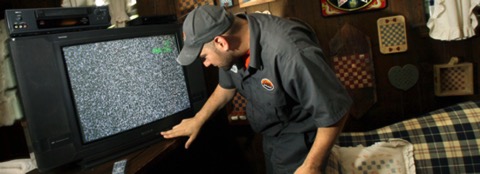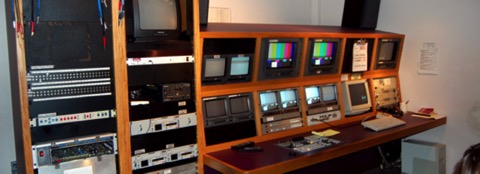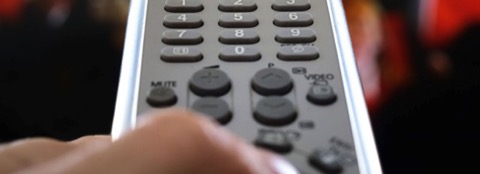
Switch-Off in Brazil
In many countries, particularly in Europe, this issue is already past. But in Brazil this is still a matter to be discussed.

The shutdown of analog TV broadcast and operation only in digital modulation in high definition is taking place gradually. We hope that in 2016, the analog TV shutdown program arrives in large cities such as São Paulo, Belo Horizonte and Rio de Janeiro.

After seven years of the first digital television broadcasting in Brazil, finally it was published in the Official Gazette, by the Ministry of Communications, the shutdown schedule of the analog signal in Brazil. The process is taking much more than it was planned before, now the task may complete in late 2018.
One of the biggest difficulties in this process is related to the geographical dimensions that Brazil has. There are numerous cities and each should have a coverage plan that makes users continue to receive the signal and watch their televisions.

In my opinion, the choice for the first capital to take off the analog signal has been known and streamlined, taking into consideration that Brasília is geographically flat, facilitating signal implementation with few repeaters.

The numbers are promising. In the first step of the program, 60% of the population will no longer have the analog signal. Subsequently, on November 25, 2018, will begin the final stage of the switch off. But I believe that as more cities have the technical feasibility by Anatel, the execution and retransmission may shutdown the analog signal before scheduled.
Those who have not migrated to receive the digital signal, will be without television.
That is the price to pay for the development of systems and is well compensated when you see the difference between the two types of technology.

It is important to know that there is another factor that drives the fact that the switch-off should come as soon as possible!
With the switch-off, the radio frequencies in the 700 MHz band will be released for mobile operators use for 3G and 4G services. The 700 MHz band has superior range to currently used and is therefore cheaper.

A question that may come to mind of the viewer is – When the analog signal will be shutdown where I live?
Thinking about it, TV stations should inform the deadline date of the analog signal and the digital programming channel.
Disclosure begins with a year in advance and will be performed in two ways: through a stripe with fixed text or moving; and the logo of analogue television with indication of the digital transmission channel. Something that will catch the attention of the viewer.
In both cases the display will last 30 seconds and follows a schedule that begins with three daily inserts and reaches 18, one month before the shutdown. In the two months prior to the shutdown is expected even a countdown that will be permanently on the screen. So if the system is not prepared for the new signal, it is time to update.

The text posted on the stripe will have the date of the shutdown and the website address on the Internet and a central free telephone service for information - to be defined by GIRED (Group of Implementation of Digitalization).
As each viewer watches TV at different time, the inserts should be distributed by one third for each period of the day: in the morning (7am to 12pm), afternoon (from 12pm to 6pm) and evening (from 6pm to 11pm).
Of course, to achieve the greatest number of viewers the information should also be transmitted on the signal of broadcast channels on cable television.
Another challenge is to end the simulcast (digital signal exactly the same as analog). As the shutdown messages will only be transmitted in analog signal, it will be necessary to adapt the generation of analog and digital signals to transmit different images.

As this change affects everyone, it will be very important to have advertising campaign for clarification to the public about the shutdown of the analog signal, including broadcast television, at least one year before the start of the process.
Check out the government's schedule for the shutdown of analogue TV:
• November 29, 2015: Pilot - Rio Verde (GO)
• April 3, 2016: Brasília (DF)
• May 15, 2016: São Paulo (SP)
• June 26, 2016: Belo Horizonte (MG)
• August 28, 2016: Goiânia (GO)
• November 27, 2016: Rio de Janeiro (RJ)
• June 25, 2017: Curitiba (PR), Florianópolis (SC) and Porto Alegre (RS)
• July 30, 2017: Salvador (BA), Fortaleza (CE) and Recife (PE)
• August 27, 2017: Campinas (SP) and Ribeirão Preto (SP)
• September 24, 2017: Vale do Paraíba (RJ) and Santos (SP)
• October 29, 2017: RJ Interior and Vitória (ES)
• November 26, 2017: São José do Rio Preto (SP), Bauru (SP) and Presidente Prudente (SP)
• July 1, 2018: Manaus (AM), Belém (PA) and São Luís (MA)
• July 29, 2018: Natal (RN), João Pessoa (PB), Maceió (AL), Aracaju (SE) and Teresina (PI)
• August 26, 2018: Campo Grande (MS), Cuiaba (MT) and Palmas (TO)
• November 25, 2018: Porto Velho (RO), Macapa (AP), Rio Branco (AC), Boa Vista (RR) and other cities.
But this schedule may change… The decree 8061/13 says that the switch-off may be more flexible, watching the new realities of the market, taking into account the use of frequency for LTE and putting in installments shutdown signal. So we will have more time to update our systems, to a near future to the deadline in 2020, contrary to the previously deadline.

However, other details are highlighted as the problem with the bandwidth occupation, we highlight all the North and Northeast capitals, except Fortaleza (CE), Recife (PE) and Salvador (BA). I believe it is necessary to deepen more studies to establish the switch-off, then pulling the deadline for 2018 between the capital cities. As there is greater demand, there is greater consumer channels in the spectrum, precluding a simple reorganization.
An example involving the local terrain, is what happens in Palmas (TO), where there is problem of location of transmission towers outside the radius of 2 km, off-location, but that can be solved with technical solution. In São Paulo (SP) it works, because there transmitters with more than 2 miles away with optimal functioning.

In research conducted, TV Globo already claims to have digital coverage of 50% of the population. Digital TV extension is much faster, but can not do at a time as low as the switch-off schedule.
The director of engineering at TV Globo, Liliane Nakonechnyj says the dynamics of the TV market is different from telecommunications, which have investment and intensive revenue. And that in fact that the change of technology, which allows the adjustment to new infrastructure, advances differently to the consumer: as a cell has short shelf life (about two years), a TV set is about ten years.
That digital is here to stay, everyone already knows. What actually is the focus is the transition project well done with future projections and perform in a timely manner. These factors are the key points for a deployment well made in Brazil. As has happened with the transition from black and white TV to color TV, we are facing a new era where broadcast, audio and video is bordering the newest art of technology with higher quality.
We would like to thank Marcel Almeida for writing for us.
More info you can find on his LinkedIn: br.linkedin.com/in/marcelmg77/en or follow him on Twitter @marcelmg77
Mentioned:
Anatel
Ministry of Communications (MiniCom)
TV Globo